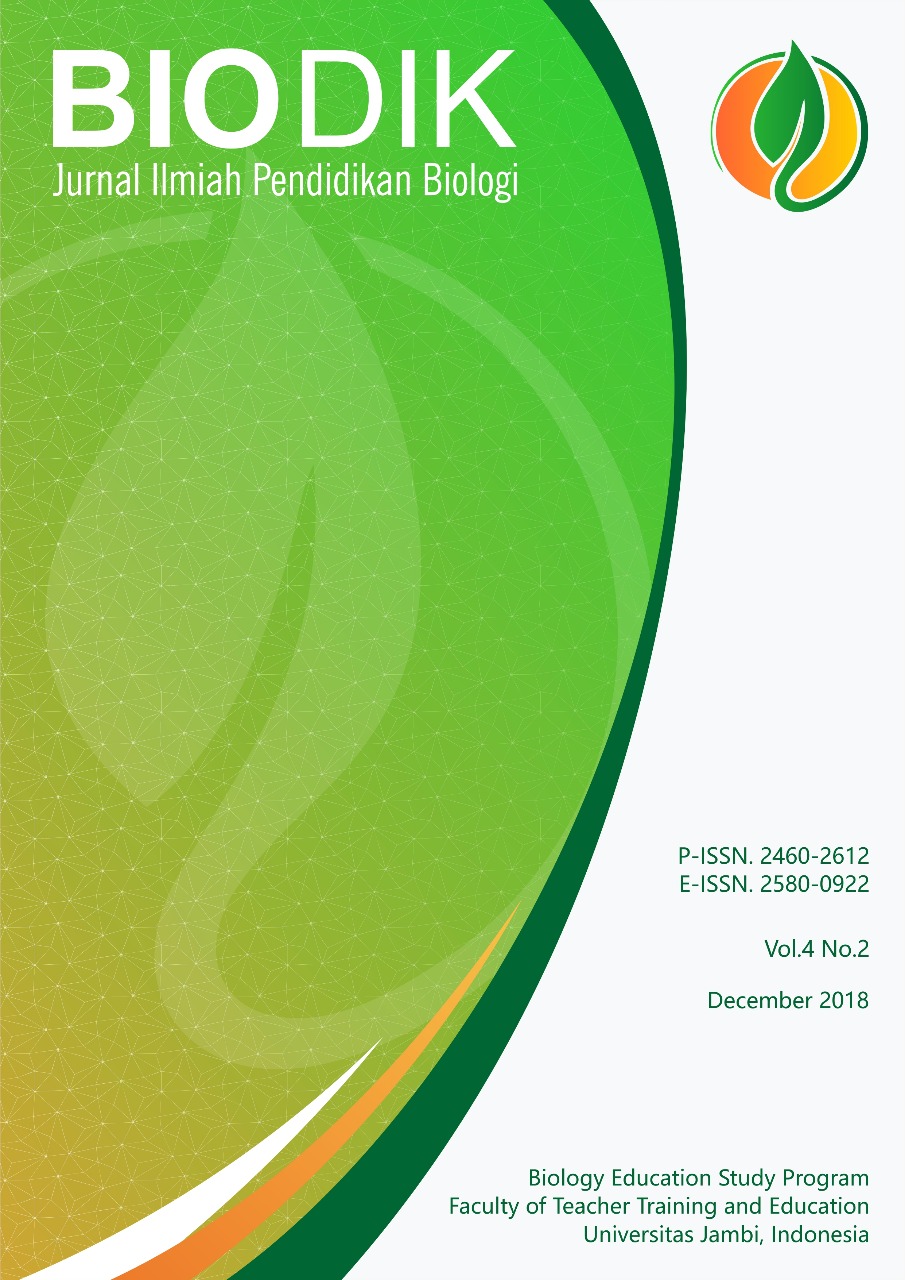Development of Electronic Learning Media Based 3D Pageflip on Subject Matter of Photosynthetis in Plant Physiology Course
DOI:
https://doi.org/10.22437/bio.v4i2.5858Abstract
The aim of this research is to develop the electronic learning media on the subject matter Plant Physiology based 3D pageflip. The 3 D Pageflip is the software that can display the learning material, like: power point, text, pictures, photos, animation, student’s worksheet and videos are integrated in one packaging. This research was designed in ADDIE’s model which have five steps, namely: Analyze, Design, Develop, Implement, and Evaluate. This media was validated by design expert and content expert. The qualitative data from expert suggession used to revise this media, while the qualitative data got from the student’s response to this media. This media was validated by design expert twice and got the last score about 44 (91.67%) with very good criteria. Then, the media also validated by content expert and obtanied the score about 36 (80%) with very good criteria. After validated, the electronic learning media trial to the biology student for the small group test with 9 students as a repondent and obtained the score about 48.87 with very good criteria, while the big group trial test with 15 student as a respondent, got the score about 49.87 with very good criteria. In conclussion, this electronic learning media on subject matter Photosynthesis for Plant Physiology course is very good to use in classroom and also individually.
Keywords: electronic media, 3D pageflip, photosynthesis, plant physiology
Abstrak
Penelitian ini bertujuan untuk mengembangkan media pembelajaran elektronik berbasis 3D Pageflip pada materi fotosintesis mata kuliah Fisiologi Tumbuhan. 3D pageflip ini merupakan software yang dapat menyajikan perangkat pembelajaran seperti: PPT, teks, gambar, foto, LKPD, lagu, animasi, dan video yang terintegrasi dalam satu paket. Media ini dirancang dengan model ADDIE yang memiliki 5 tahapan, yaitu: Analisis, Desain, Develop, Implementasi, dan Evaluasi. Media elektronik ini divalidasi oleh ahli desain media dan ahli. Data kualitatif berupa saran diperoleh dari ahli desain dan ahli materi digunakan untuk merevisi media. Setelah media dinyatakan layak maka dilanjutkan dengan uji kelompok kecil dan besar untuk melihat repons mahasiswa biologi. Validasi desain media elektrnoik berbasis 3D pageflip dilakukan sebanyak 2 kali dan diperoleh skor akhir sebesar 44 (91.67%) dengan kriteria sangat baik. Kemudian media divalidasi oleh ahli materi juga sebanyak 2 kali dan diperoleh skor akhir sebesar 36 (80%) dengan kriteria sangat baik. Hasil ujicoba kelompok kecil dengan 9 orang mahasiswa pendidikan biologi sebagai responden dan diperoleh skor sebesar 48.87 dengan kriteria sangat baik/sangat setuju. Selanjutnya hasil ujicoba kelompok besar dengan jumlah mahasiswa sebanyak 15 orang diperoleh skor sebesar 49.87 dengan kriteria juga sangat baik. Dapat disimpulkan bahwa media pembelajaran elektronik berbasis 3D pageflip pada materi fotosintesis mata kuliah Fisiologi Tumbuhan sangat layak digunakan dalam pembelajaran di kelas maupun secara individu.
Kata kunci: media elektronik, 3D pageflip, fisiologi tumbuhan
Downloads
Downloads
Published
Versions
- 2018-12-03 (1)
- 2018-12-03 (1)
How to Cite
Issue
Section
License
Copyright Notice
Authors who publish with Biodik : Jurnal Ilmiah Pendidikan Biologi agree to the following terms:
- For all articles published in Biodik : Jurnal Ilmiah Pendidikan Biologi, copyright is retained by the authors and grant the journal right of first publication with the work simultaneously licensed under a Creative Commons Attribution-ShareAlike 4.0 International Licensethat allows others to share the work with an acknowledgment of the work's authorship and initial publication in this journal.
- Authors are able to enter into separate, additional contractual arrangements for the non-exclusive distribution of the journal's published version of the work (e.g., post it to an institutional repository or publish it in a book), with an acknowledgment of its initial publication in this journal.
- Authors are permitted and encouraged to post their work online (e.g., in institutional repositories or on their website) prior to and during the submission process, as it can lead to productive exchanges, as well as earlier and greater citation of published work (See The Effect of Open Access).
















